Comprehensive Review of Feminist Theory: Concepts and Activism
VerifiedAdded on 2022/12/03
|8
|2052
|286
Literature Review
AI Summary
This literature review provides a comprehensive overview of feminist theory, examining its evolution and key concepts. It delves into the concept of intersectionality, highlighting how women experience oppression across various dimensions such as race, gender, ethnicity, and class. The review explores the complexities of white feminism and black feminism, and the importance of studying feminism from an intersectional perspective. It also examines the relationship between masculinity and feminism, discussing how societal constructs shape gender identities and the interpretation of masculinity. Furthermore, the review analyzes feminist activism, including movements like #MeToo and Slutwalk, and the role of digital media in amplifying feminist voices. The review identifies gaps in the current literature, particularly the need for research on how well people understand the concepts of feminism, and concludes by emphasizing the ongoing relevance of feminist theory in contemporary society.
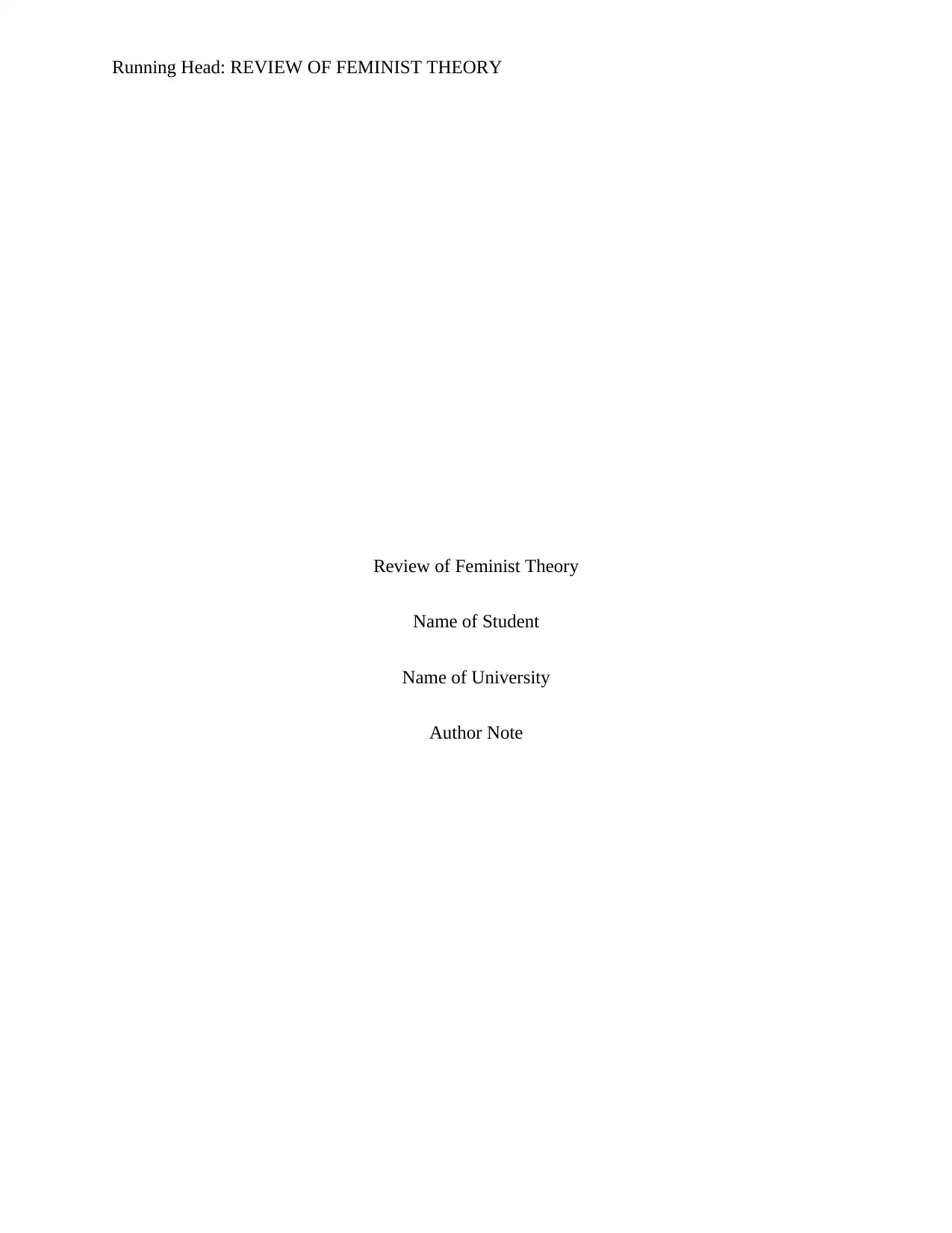
Running Head: REVIEW OF FEMINIST THEORY
Review of Feminist Theory
Name of Student
Name of University
Author Note
Review of Feminist Theory
Name of Student
Name of University
Author Note
Paraphrase This Document
Need a fresh take? Get an instant paraphrase of this document with our AI Paraphraser
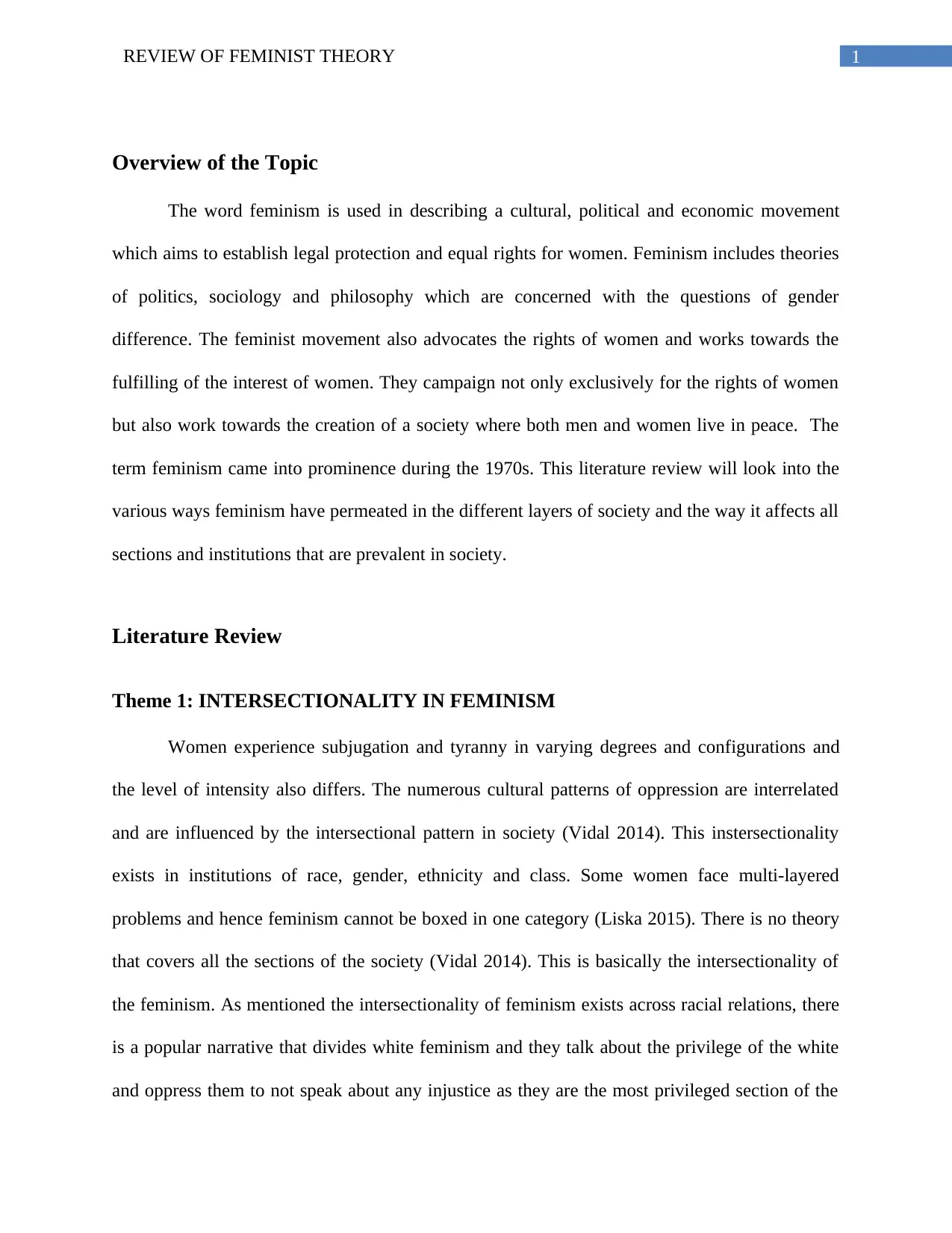
1REVIEW OF FEMINIST THEORY
Overview of the Topic
The word feminism is used in describing a cultural, political and economic movement
which aims to establish legal protection and equal rights for women. Feminism includes theories
of politics, sociology and philosophy which are concerned with the questions of gender
difference. The feminist movement also advocates the rights of women and works towards the
fulfilling of the interest of women. They campaign not only exclusively for the rights of women
but also work towards the creation of a society where both men and women live in peace. The
term feminism came into prominence during the 1970s. This literature review will look into the
various ways feminism have permeated in the different layers of society and the way it affects all
sections and institutions that are prevalent in society.
Literature Review
Theme 1: INTERSECTIONALITY IN FEMINISM
Women experience subjugation and tyranny in varying degrees and configurations and
the level of intensity also differs. The numerous cultural patterns of oppression are interrelated
and are influenced by the intersectional pattern in society (Vidal 2014). This instersectionality
exists in institutions of race, gender, ethnicity and class. Some women face multi-layered
problems and hence feminism cannot be boxed in one category (Liska 2015). There is no theory
that covers all the sections of the society (Vidal 2014). This is basically the intersectionality of
the feminism. As mentioned the intersectionality of feminism exists across racial relations, there
is a popular narrative that divides white feminism and they talk about the privilege of the white
and oppress them to not speak about any injustice as they are the most privileged section of the
Overview of the Topic
The word feminism is used in describing a cultural, political and economic movement
which aims to establish legal protection and equal rights for women. Feminism includes theories
of politics, sociology and philosophy which are concerned with the questions of gender
difference. The feminist movement also advocates the rights of women and works towards the
fulfilling of the interest of women. They campaign not only exclusively for the rights of women
but also work towards the creation of a society where both men and women live in peace. The
term feminism came into prominence during the 1970s. This literature review will look into the
various ways feminism have permeated in the different layers of society and the way it affects all
sections and institutions that are prevalent in society.
Literature Review
Theme 1: INTERSECTIONALITY IN FEMINISM
Women experience subjugation and tyranny in varying degrees and configurations and
the level of intensity also differs. The numerous cultural patterns of oppression are interrelated
and are influenced by the intersectional pattern in society (Vidal 2014). This instersectionality
exists in institutions of race, gender, ethnicity and class. Some women face multi-layered
problems and hence feminism cannot be boxed in one category (Liska 2015). There is no theory
that covers all the sections of the society (Vidal 2014). This is basically the intersectionality of
the feminism. As mentioned the intersectionality of feminism exists across racial relations, there
is a popular narrative that divides white feminism and they talk about the privilege of the white
and oppress them to not speak about any injustice as they are the most privileged section of the
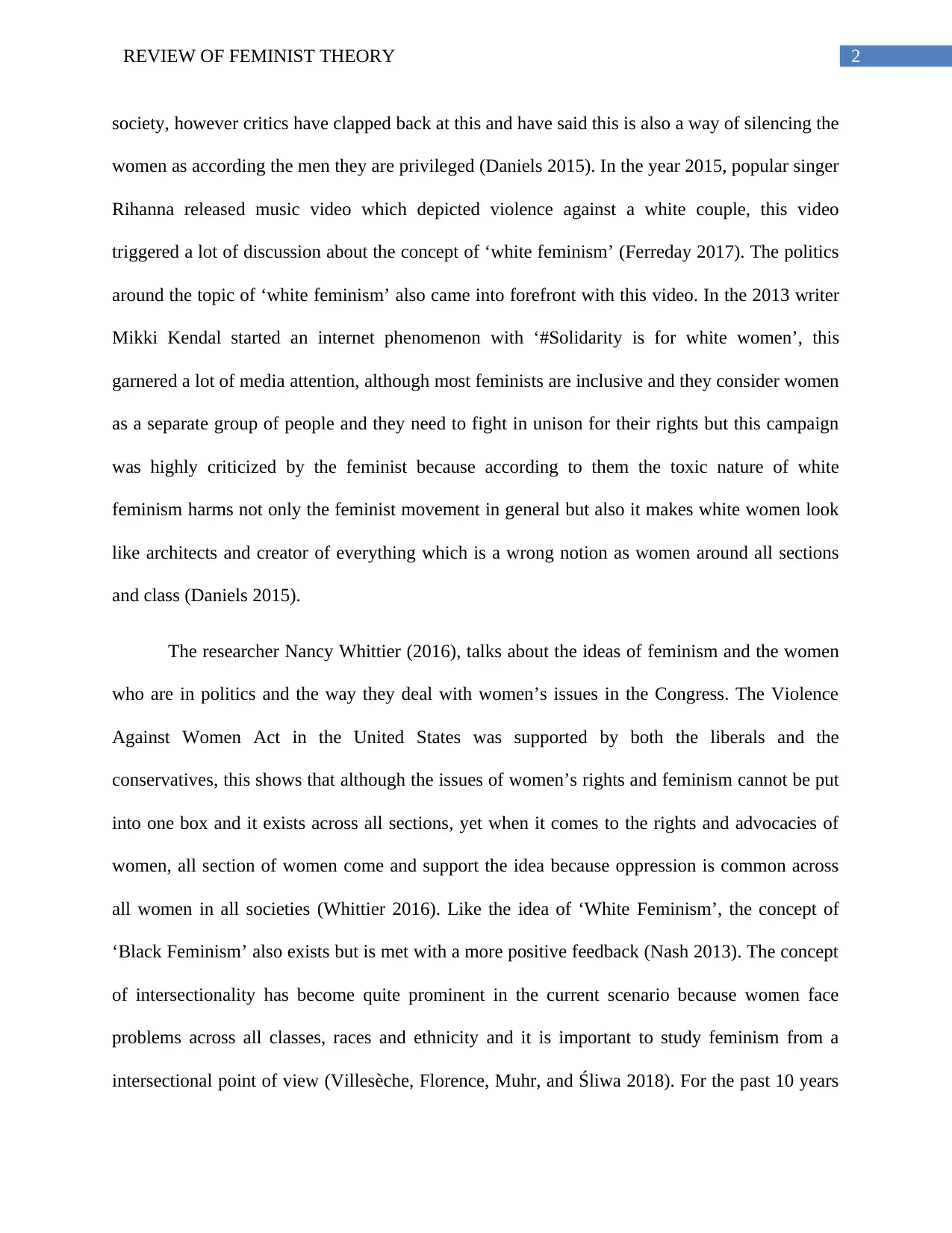
2REVIEW OF FEMINIST THEORY
society, however critics have clapped back at this and have said this is also a way of silencing the
women as according the men they are privileged (Daniels 2015). In the year 2015, popular singer
Rihanna released music video which depicted violence against a white couple, this video
triggered a lot of discussion about the concept of ‘white feminism’ (Ferreday 2017). The politics
around the topic of ‘white feminism’ also came into forefront with this video. In the 2013 writer
Mikki Kendal started an internet phenomenon with ‘#Solidarity is for white women’, this
garnered a lot of media attention, although most feminists are inclusive and they consider women
as a separate group of people and they need to fight in unison for their rights but this campaign
was highly criticized by the feminist because according to them the toxic nature of white
feminism harms not only the feminist movement in general but also it makes white women look
like architects and creator of everything which is a wrong notion as women around all sections
and class (Daniels 2015).
The researcher Nancy Whittier (2016), talks about the ideas of feminism and the women
who are in politics and the way they deal with women’s issues in the Congress. The Violence
Against Women Act in the United States was supported by both the liberals and the
conservatives, this shows that although the issues of women’s rights and feminism cannot be put
into one box and it exists across all sections, yet when it comes to the rights and advocacies of
women, all section of women come and support the idea because oppression is common across
all women in all societies (Whittier 2016). Like the idea of ‘White Feminism’, the concept of
‘Black Feminism’ also exists but is met with a more positive feedback (Nash 2013). The concept
of intersectionality has become quite prominent in the current scenario because women face
problems across all classes, races and ethnicity and it is important to study feminism from a
intersectional point of view (Villesèche, Florence, Muhr, and Śliwa 2018). For the past 10 years
society, however critics have clapped back at this and have said this is also a way of silencing the
women as according the men they are privileged (Daniels 2015). In the year 2015, popular singer
Rihanna released music video which depicted violence against a white couple, this video
triggered a lot of discussion about the concept of ‘white feminism’ (Ferreday 2017). The politics
around the topic of ‘white feminism’ also came into forefront with this video. In the 2013 writer
Mikki Kendal started an internet phenomenon with ‘#Solidarity is for white women’, this
garnered a lot of media attention, although most feminists are inclusive and they consider women
as a separate group of people and they need to fight in unison for their rights but this campaign
was highly criticized by the feminist because according to them the toxic nature of white
feminism harms not only the feminist movement in general but also it makes white women look
like architects and creator of everything which is a wrong notion as women around all sections
and class (Daniels 2015).
The researcher Nancy Whittier (2016), talks about the ideas of feminism and the women
who are in politics and the way they deal with women’s issues in the Congress. The Violence
Against Women Act in the United States was supported by both the liberals and the
conservatives, this shows that although the issues of women’s rights and feminism cannot be put
into one box and it exists across all sections, yet when it comes to the rights and advocacies of
women, all section of women come and support the idea because oppression is common across
all women in all societies (Whittier 2016). Like the idea of ‘White Feminism’, the concept of
‘Black Feminism’ also exists but is met with a more positive feedback (Nash 2013). The concept
of intersectionality has become quite prominent in the current scenario because women face
problems across all classes, races and ethnicity and it is important to study feminism from a
intersectional point of view (Villesèche, Florence, Muhr, and Śliwa 2018). For the past 10 years
⊘ This is a preview!⊘
Do you want full access?
Subscribe today to unlock all pages.

Trusted by 1+ million students worldwide
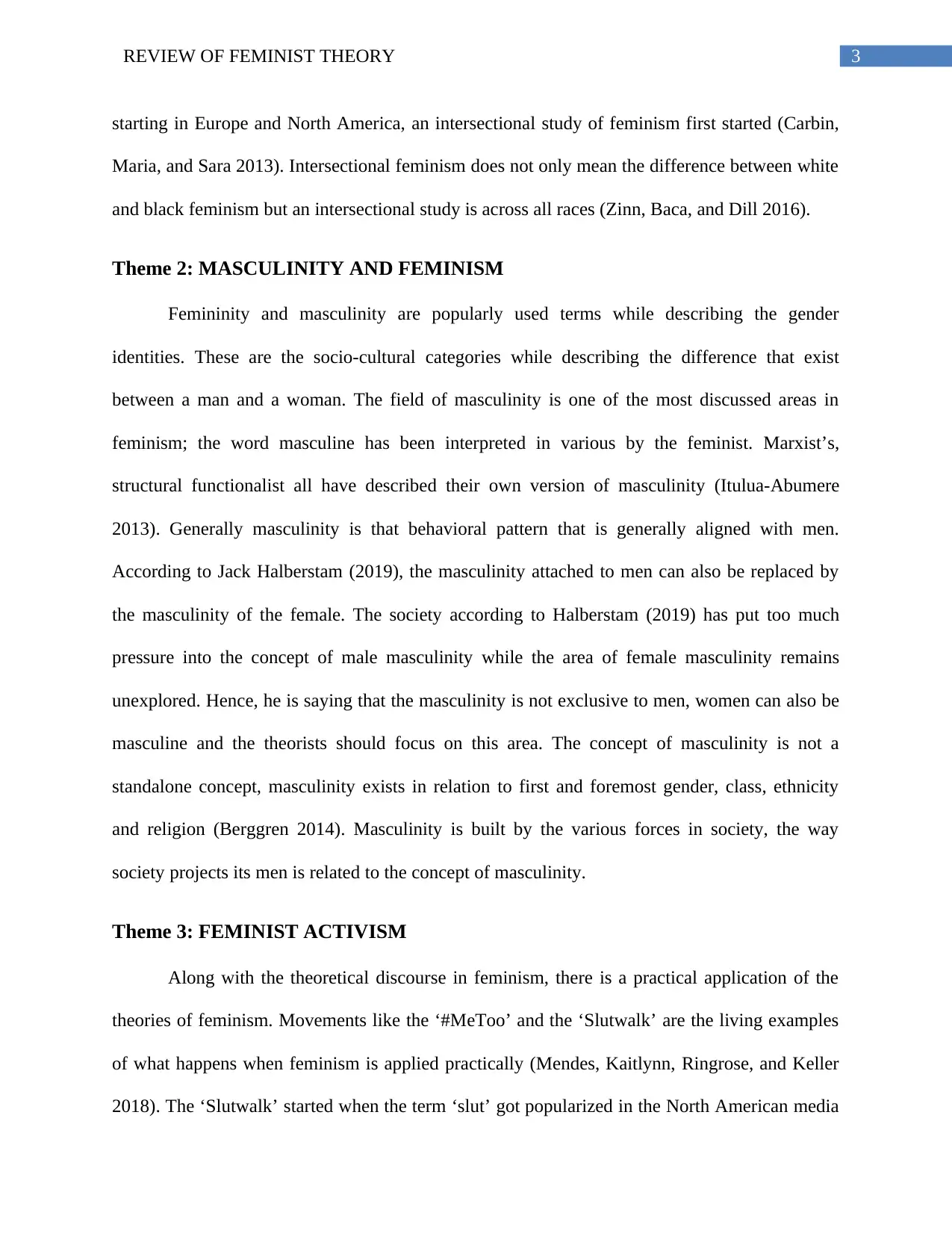
3REVIEW OF FEMINIST THEORY
starting in Europe and North America, an intersectional study of feminism first started (Carbin,
Maria, and Sara 2013). Intersectional feminism does not only mean the difference between white
and black feminism but an intersectional study is across all races (Zinn, Baca, and Dill 2016).
Theme 2: MASCULINITY AND FEMINISM
Femininity and masculinity are popularly used terms while describing the gender
identities. These are the socio-cultural categories while describing the difference that exist
between a man and a woman. The field of masculinity is one of the most discussed areas in
feminism; the word masculine has been interpreted in various by the feminist. Marxist’s,
structural functionalist all have described their own version of masculinity (Itulua-Abumere
2013). Generally masculinity is that behavioral pattern that is generally aligned with men.
According to Jack Halberstam (2019), the masculinity attached to men can also be replaced by
the masculinity of the female. The society according to Halberstam (2019) has put too much
pressure into the concept of male masculinity while the area of female masculinity remains
unexplored. Hence, he is saying that the masculinity is not exclusive to men, women can also be
masculine and the theorists should focus on this area. The concept of masculinity is not a
standalone concept, masculinity exists in relation to first and foremost gender, class, ethnicity
and religion (Berggren 2014). Masculinity is built by the various forces in society, the way
society projects its men is related to the concept of masculinity.
Theme 3: FEMINIST ACTIVISM
Along with the theoretical discourse in feminism, there is a practical application of the
theories of feminism. Movements like the ‘#MeToo’ and the ‘Slutwalk’ are the living examples
of what happens when feminism is applied practically (Mendes, Kaitlynn, Ringrose, and Keller
2018). The ‘Slutwalk’ started when the term ‘slut’ got popularized in the North American media
starting in Europe and North America, an intersectional study of feminism first started (Carbin,
Maria, and Sara 2013). Intersectional feminism does not only mean the difference between white
and black feminism but an intersectional study is across all races (Zinn, Baca, and Dill 2016).
Theme 2: MASCULINITY AND FEMINISM
Femininity and masculinity are popularly used terms while describing the gender
identities. These are the socio-cultural categories while describing the difference that exist
between a man and a woman. The field of masculinity is one of the most discussed areas in
feminism; the word masculine has been interpreted in various by the feminist. Marxist’s,
structural functionalist all have described their own version of masculinity (Itulua-Abumere
2013). Generally masculinity is that behavioral pattern that is generally aligned with men.
According to Jack Halberstam (2019), the masculinity attached to men can also be replaced by
the masculinity of the female. The society according to Halberstam (2019) has put too much
pressure into the concept of male masculinity while the area of female masculinity remains
unexplored. Hence, he is saying that the masculinity is not exclusive to men, women can also be
masculine and the theorists should focus on this area. The concept of masculinity is not a
standalone concept, masculinity exists in relation to first and foremost gender, class, ethnicity
and religion (Berggren 2014). Masculinity is built by the various forces in society, the way
society projects its men is related to the concept of masculinity.
Theme 3: FEMINIST ACTIVISM
Along with the theoretical discourse in feminism, there is a practical application of the
theories of feminism. Movements like the ‘#MeToo’ and the ‘Slutwalk’ are the living examples
of what happens when feminism is applied practically (Mendes, Kaitlynn, Ringrose, and Keller
2018). The ‘Slutwalk’ started when the term ‘slut’ got popularized in the North American media
Paraphrase This Document
Need a fresh take? Get an instant paraphrase of this document with our AI Paraphraser
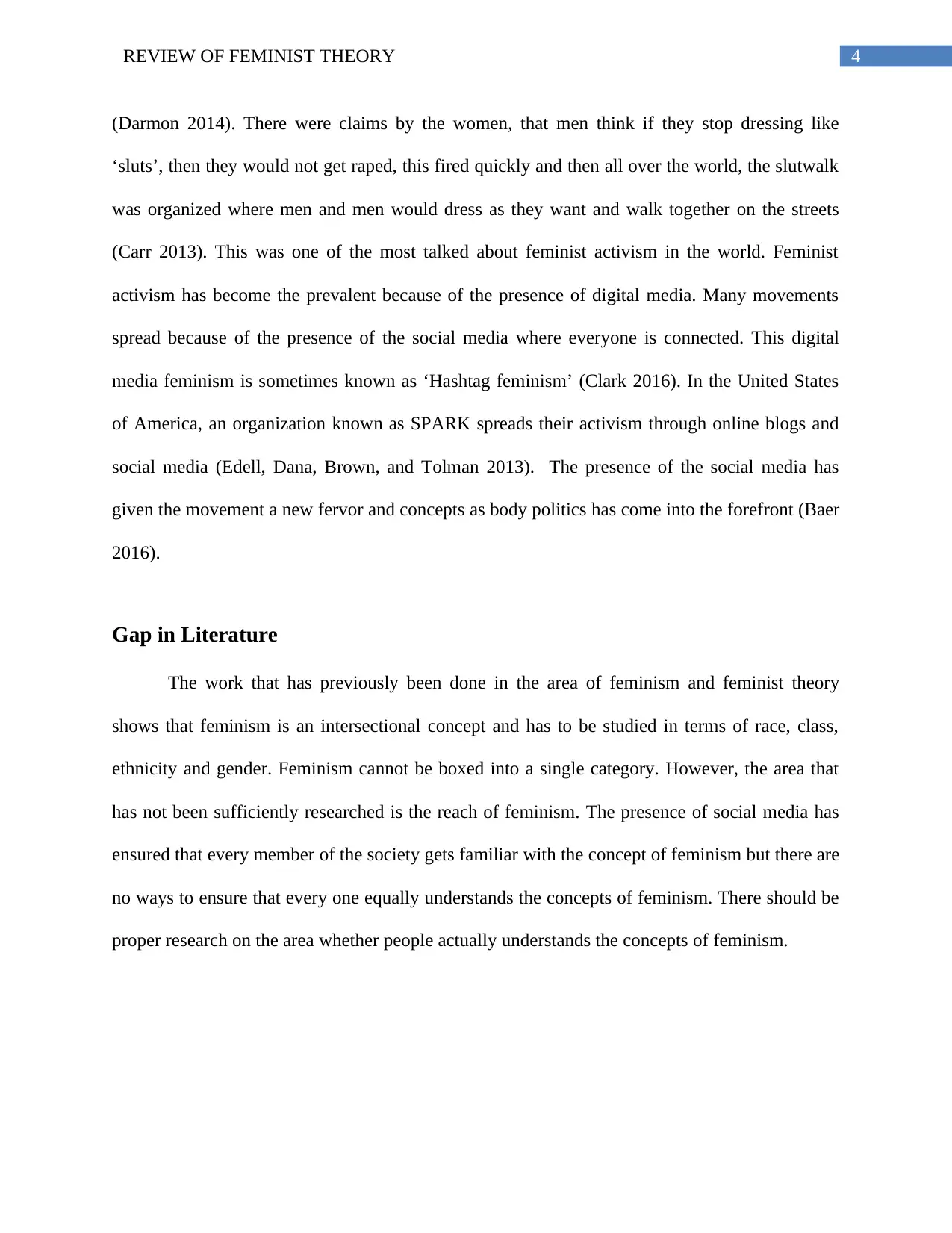
4REVIEW OF FEMINIST THEORY
(Darmon 2014). There were claims by the women, that men think if they stop dressing like
‘sluts’, then they would not get raped, this fired quickly and then all over the world, the slutwalk
was organized where men and men would dress as they want and walk together on the streets
(Carr 2013). This was one of the most talked about feminist activism in the world. Feminist
activism has become the prevalent because of the presence of digital media. Many movements
spread because of the presence of the social media where everyone is connected. This digital
media feminism is sometimes known as ‘Hashtag feminism’ (Clark 2016). In the United States
of America, an organization known as SPARK spreads their activism through online blogs and
social media (Edell, Dana, Brown, and Tolman 2013). The presence of the social media has
given the movement a new fervor and concepts as body politics has come into the forefront (Baer
2016).
Gap in Literature
The work that has previously been done in the area of feminism and feminist theory
shows that feminism is an intersectional concept and has to be studied in terms of race, class,
ethnicity and gender. Feminism cannot be boxed into a single category. However, the area that
has not been sufficiently researched is the reach of feminism. The presence of social media has
ensured that every member of the society gets familiar with the concept of feminism but there are
no ways to ensure that every one equally understands the concepts of feminism. There should be
proper research on the area whether people actually understands the concepts of feminism.
(Darmon 2014). There were claims by the women, that men think if they stop dressing like
‘sluts’, then they would not get raped, this fired quickly and then all over the world, the slutwalk
was organized where men and men would dress as they want and walk together on the streets
(Carr 2013). This was one of the most talked about feminist activism in the world. Feminist
activism has become the prevalent because of the presence of digital media. Many movements
spread because of the presence of the social media where everyone is connected. This digital
media feminism is sometimes known as ‘Hashtag feminism’ (Clark 2016). In the United States
of America, an organization known as SPARK spreads their activism through online blogs and
social media (Edell, Dana, Brown, and Tolman 2013). The presence of the social media has
given the movement a new fervor and concepts as body politics has come into the forefront (Baer
2016).
Gap in Literature
The work that has previously been done in the area of feminism and feminist theory
shows that feminism is an intersectional concept and has to be studied in terms of race, class,
ethnicity and gender. Feminism cannot be boxed into a single category. However, the area that
has not been sufficiently researched is the reach of feminism. The presence of social media has
ensured that every member of the society gets familiar with the concept of feminism but there are
no ways to ensure that every one equally understands the concepts of feminism. There should be
proper research on the area whether people actually understands the concepts of feminism.
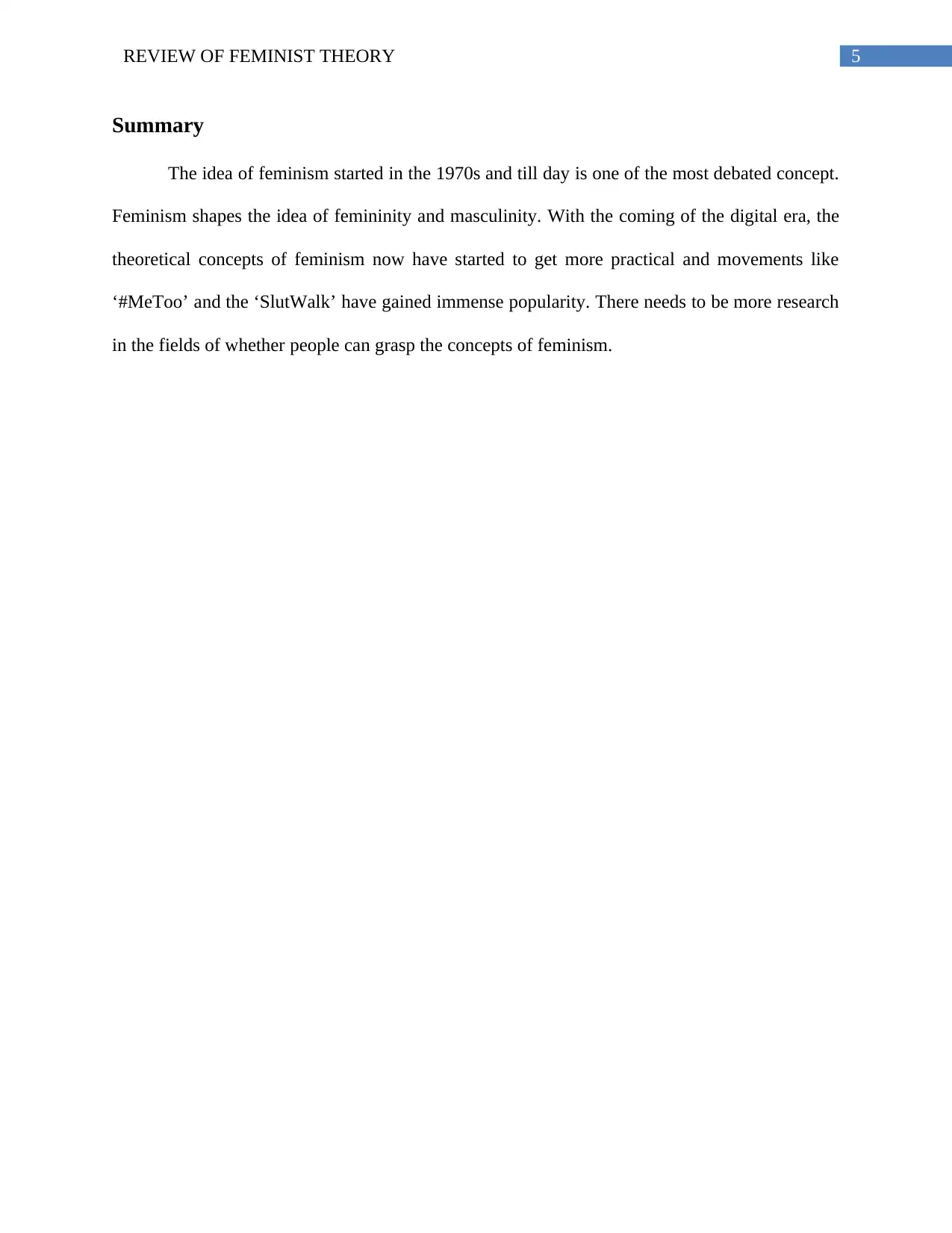
5REVIEW OF FEMINIST THEORY
Summary
The idea of feminism started in the 1970s and till day is one of the most debated concept.
Feminism shapes the idea of femininity and masculinity. With the coming of the digital era, the
theoretical concepts of feminism now have started to get more practical and movements like
‘#MeToo’ and the ‘SlutWalk’ have gained immense popularity. There needs to be more research
in the fields of whether people can grasp the concepts of feminism.
Summary
The idea of feminism started in the 1970s and till day is one of the most debated concept.
Feminism shapes the idea of femininity and masculinity. With the coming of the digital era, the
theoretical concepts of feminism now have started to get more practical and movements like
‘#MeToo’ and the ‘SlutWalk’ have gained immense popularity. There needs to be more research
in the fields of whether people can grasp the concepts of feminism.
⊘ This is a preview!⊘
Do you want full access?
Subscribe today to unlock all pages.

Trusted by 1+ million students worldwide
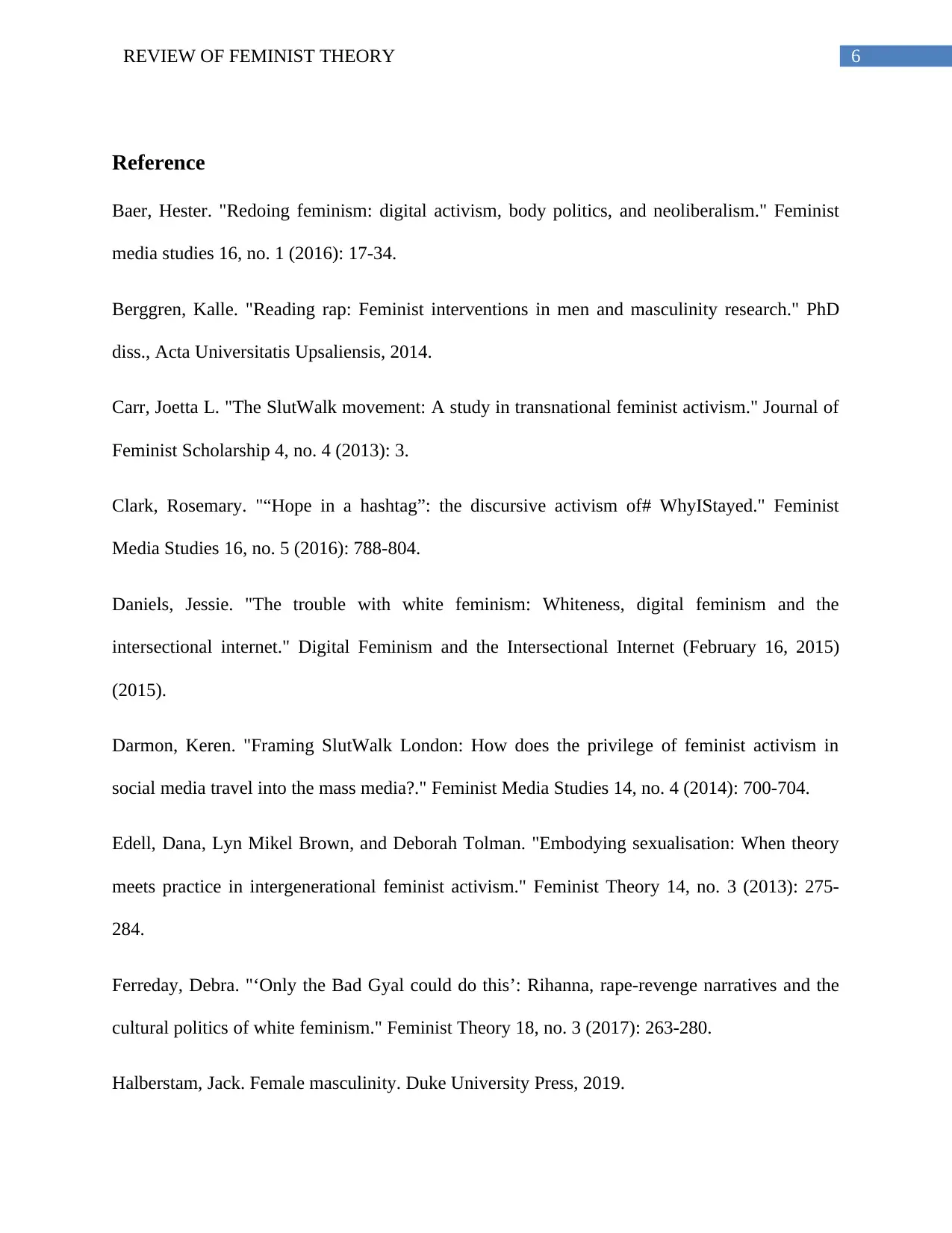
6REVIEW OF FEMINIST THEORY
Reference
Baer, Hester. "Redoing feminism: digital activism, body politics, and neoliberalism." Feminist
media studies 16, no. 1 (2016): 17-34.
Berggren, Kalle. "Reading rap: Feminist interventions in men and masculinity research." PhD
diss., Acta Universitatis Upsaliensis, 2014.
Carr, Joetta L. "The SlutWalk movement: A study in transnational feminist activism." Journal of
Feminist Scholarship 4, no. 4 (2013): 3.
Clark, Rosemary. "“Hope in a hashtag”: the discursive activism of# WhyIStayed." Feminist
Media Studies 16, no. 5 (2016): 788-804.
Daniels, Jessie. "The trouble with white feminism: Whiteness, digital feminism and the
intersectional internet." Digital Feminism and the Intersectional Internet (February 16, 2015)
(2015).
Darmon, Keren. "Framing SlutWalk London: How does the privilege of feminist activism in
social media travel into the mass media?." Feminist Media Studies 14, no. 4 (2014): 700-704.
Edell, Dana, Lyn Mikel Brown, and Deborah Tolman. "Embodying sexualisation: When theory
meets practice in intergenerational feminist activism." Feminist Theory 14, no. 3 (2013): 275-
284.
Ferreday, Debra. "‘Only the Bad Gyal could do this’: Rihanna, rape-revenge narratives and the
cultural politics of white feminism." Feminist Theory 18, no. 3 (2017): 263-280.
Halberstam, Jack. Female masculinity. Duke University Press, 2019.
Reference
Baer, Hester. "Redoing feminism: digital activism, body politics, and neoliberalism." Feminist
media studies 16, no. 1 (2016): 17-34.
Berggren, Kalle. "Reading rap: Feminist interventions in men and masculinity research." PhD
diss., Acta Universitatis Upsaliensis, 2014.
Carr, Joetta L. "The SlutWalk movement: A study in transnational feminist activism." Journal of
Feminist Scholarship 4, no. 4 (2013): 3.
Clark, Rosemary. "“Hope in a hashtag”: the discursive activism of# WhyIStayed." Feminist
Media Studies 16, no. 5 (2016): 788-804.
Daniels, Jessie. "The trouble with white feminism: Whiteness, digital feminism and the
intersectional internet." Digital Feminism and the Intersectional Internet (February 16, 2015)
(2015).
Darmon, Keren. "Framing SlutWalk London: How does the privilege of feminist activism in
social media travel into the mass media?." Feminist Media Studies 14, no. 4 (2014): 700-704.
Edell, Dana, Lyn Mikel Brown, and Deborah Tolman. "Embodying sexualisation: When theory
meets practice in intergenerational feminist activism." Feminist Theory 14, no. 3 (2013): 275-
284.
Ferreday, Debra. "‘Only the Bad Gyal could do this’: Rihanna, rape-revenge narratives and the
cultural politics of white feminism." Feminist Theory 18, no. 3 (2017): 263-280.
Halberstam, Jack. Female masculinity. Duke University Press, 2019.
Paraphrase This Document
Need a fresh take? Get an instant paraphrase of this document with our AI Paraphraser
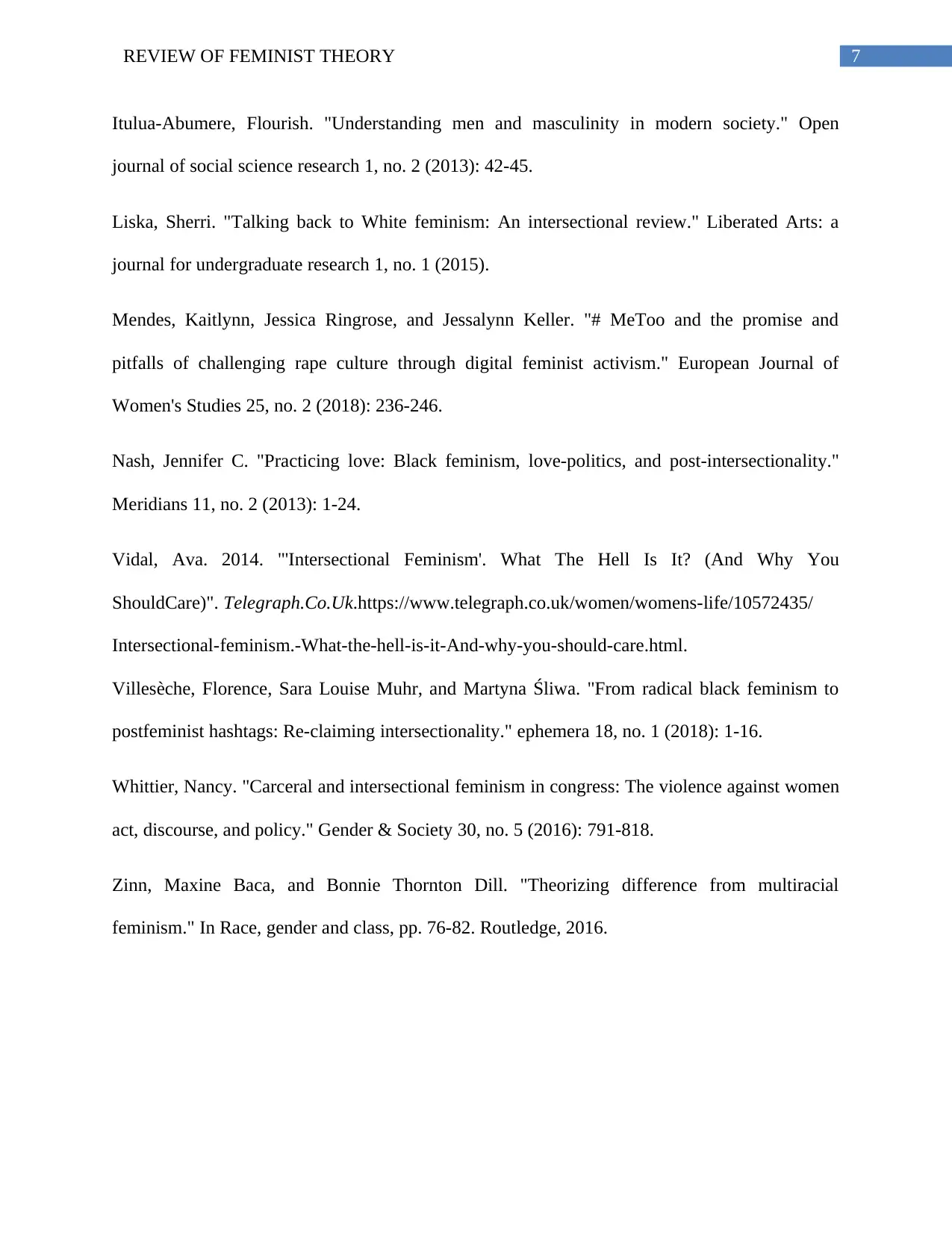
7REVIEW OF FEMINIST THEORY
Itulua-Abumere, Flourish. "Understanding men and masculinity in modern society." Open
journal of social science research 1, no. 2 (2013): 42-45.
Liska, Sherri. "Talking back to White feminism: An intersectional review." Liberated Arts: a
journal for undergraduate research 1, no. 1 (2015).
Mendes, Kaitlynn, Jessica Ringrose, and Jessalynn Keller. "# MeToo and the promise and
pitfalls of challenging rape culture through digital feminist activism." European Journal of
Women's Studies 25, no. 2 (2018): 236-246.
Nash, Jennifer C. "Practicing love: Black feminism, love-politics, and post-intersectionality."
Meridians 11, no. 2 (2013): 1-24.
Vidal, Ava. 2014. "'Intersectional Feminism'. What The Hell Is It? (And Why You
ShouldCare)". Telegraph.Co.Uk.https://www.telegraph.co.uk/women/womens-life/10572435/
Intersectional-feminism.-What-the-hell-is-it-And-why-you-should-care.html.
Villesèche, Florence, Sara Louise Muhr, and Martyna Śliwa. "From radical black feminism to
postfeminist hashtags: Re-claiming intersectionality." ephemera 18, no. 1 (2018): 1-16.
Whittier, Nancy. "Carceral and intersectional feminism in congress: The violence against women
act, discourse, and policy." Gender & Society 30, no. 5 (2016): 791-818.
Zinn, Maxine Baca, and Bonnie Thornton Dill. "Theorizing difference from multiracial
feminism." In Race, gender and class, pp. 76-82. Routledge, 2016.
Itulua-Abumere, Flourish. "Understanding men and masculinity in modern society." Open
journal of social science research 1, no. 2 (2013): 42-45.
Liska, Sherri. "Talking back to White feminism: An intersectional review." Liberated Arts: a
journal for undergraduate research 1, no. 1 (2015).
Mendes, Kaitlynn, Jessica Ringrose, and Jessalynn Keller. "# MeToo and the promise and
pitfalls of challenging rape culture through digital feminist activism." European Journal of
Women's Studies 25, no. 2 (2018): 236-246.
Nash, Jennifer C. "Practicing love: Black feminism, love-politics, and post-intersectionality."
Meridians 11, no. 2 (2013): 1-24.
Vidal, Ava. 2014. "'Intersectional Feminism'. What The Hell Is It? (And Why You
ShouldCare)". Telegraph.Co.Uk.https://www.telegraph.co.uk/women/womens-life/10572435/
Intersectional-feminism.-What-the-hell-is-it-And-why-you-should-care.html.
Villesèche, Florence, Sara Louise Muhr, and Martyna Śliwa. "From radical black feminism to
postfeminist hashtags: Re-claiming intersectionality." ephemera 18, no. 1 (2018): 1-16.
Whittier, Nancy. "Carceral and intersectional feminism in congress: The violence against women
act, discourse, and policy." Gender & Society 30, no. 5 (2016): 791-818.
Zinn, Maxine Baca, and Bonnie Thornton Dill. "Theorizing difference from multiracial
feminism." In Race, gender and class, pp. 76-82. Routledge, 2016.
1 out of 8
Related Documents
Your All-in-One AI-Powered Toolkit for Academic Success.
+13062052269
info@desklib.com
Available 24*7 on WhatsApp / Email
![[object Object]](/_next/static/media/star-bottom.7253800d.svg)
Unlock your academic potential
Copyright © 2020–2025 A2Z Services. All Rights Reserved. Developed and managed by ZUCOL.





